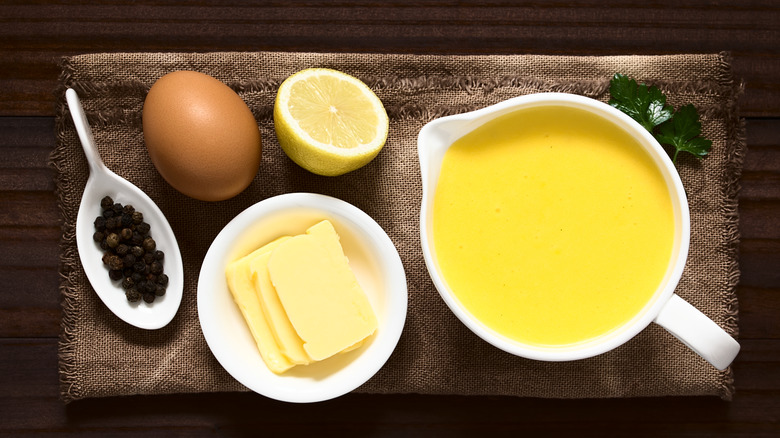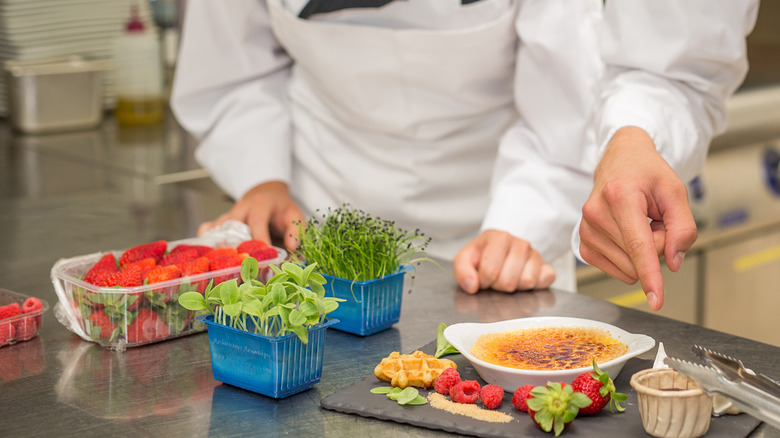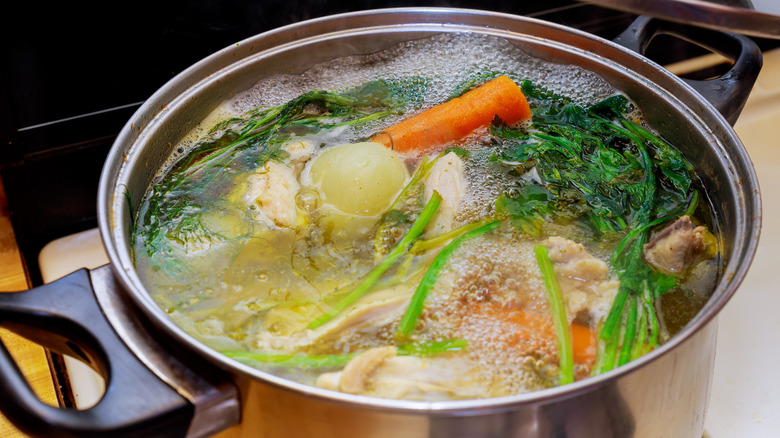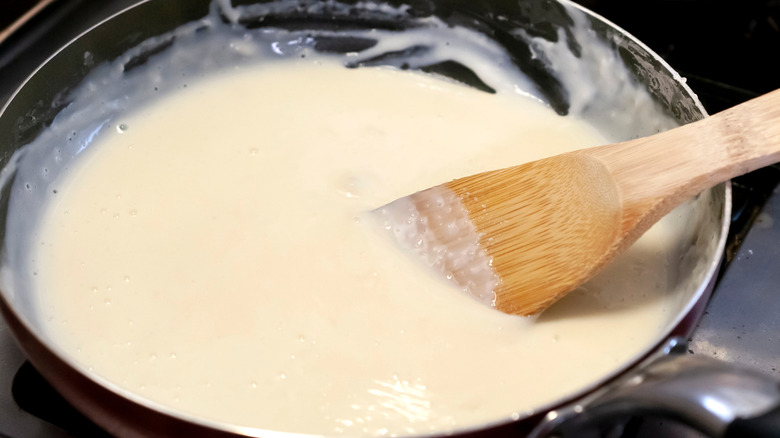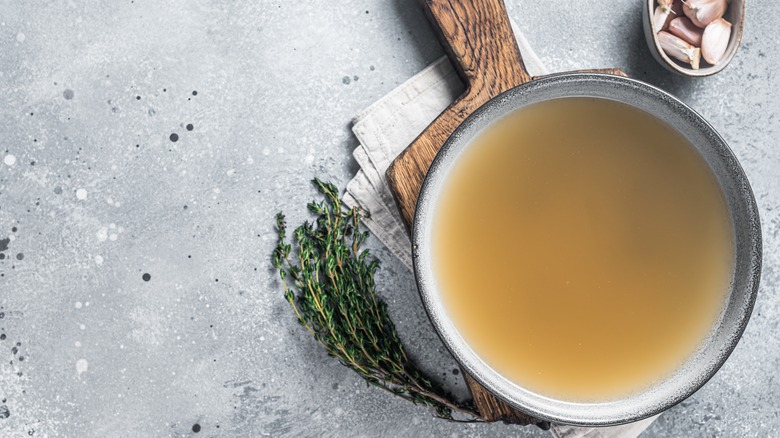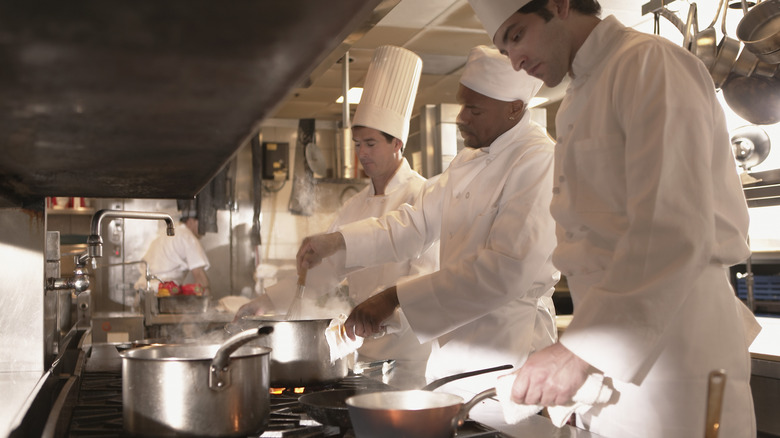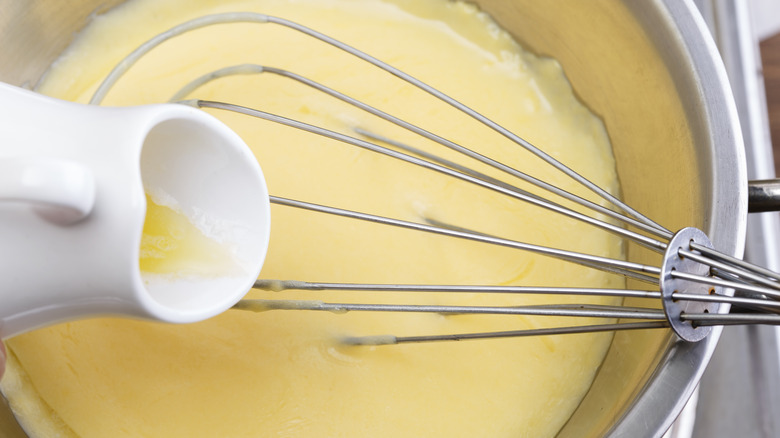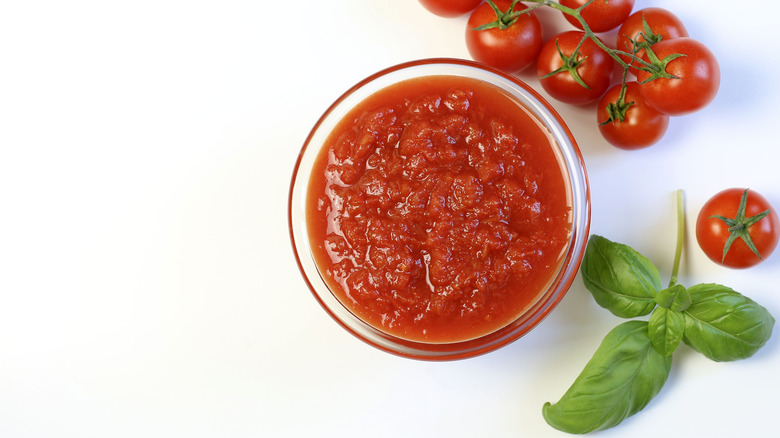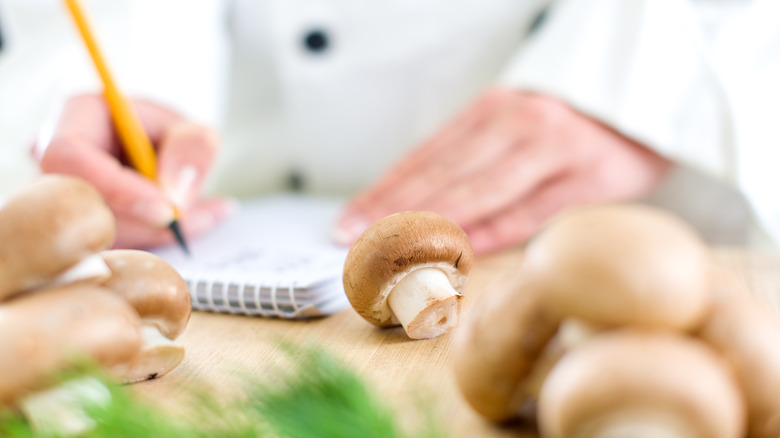Facts You Should Master About The 5 French 'Mother' Sauces
When it comes to food, every culture has a unique way of making its meals and appealing to the unique taste of its people. According to a 2011 study published in the Biological Sciences volume of the Philosophical Transactions of the Royal Society B, over 3,814 cultures exist in the world. This means that there are nearly 4,000 unique ways of creating palates, and even more means of satisfying their inclinations. Amid so many contributions to global cuisine, only a select few cultures have managed to get their food on the central stage.
One of these is the French, who continue to remain a world power in everything culinary. French food is, to put it simply, an exquisite joy. So much care and attention are taken in making French meals that French cuisine has fast risen to become the world's leader in high-quality, immersive gastronomy, according to Gastronomos.
A major reason for the massive success of French cuisine is that they've gone beyond making great French food alone to making great food everywhere in the world. Here's how — French food has formed the basis for other meals through the Mother sauces. Béchamel, velouté, hollandaise, Espagnole, and sauce tomate are the five sauces that form the basis for French and non-French meals. As you'll soon learn, many details about these Mother Sauces are crafted as delicately as their meals to create a high-quality base for food everywhere.
The five Mother sauces evolved differently
Genius as it would have been, one person did not sit at a stove and whip up the five Mother sauces all on their own. They were created by different chefs in different places, and under circumstances that couldn't have been farther apart.
According to Food Timeline, Béchamel is believed to have been created in the 1700s by a chef of the court of King Louis XVI. As a compliment, the creator named it after Marquis Louis de Béchameil, a renowned financier and chief steward of the court. Espagnole also has royal roots in the 17th-century reign of Louis XIII, but its source is hardly complimentary. According to the Auguste Escoffier School of Culinary Arts, the Espagnole recipe was created as a snub to the French royal cooks!
Velouté, on the other hand, has a thoroughly regal name that directly translates to "velvety," but with unclear origins. There's not much known about the creator of velouté, but according to ifood.tv, the sauce was first mentioned by the internationally-renowned chef, Marie-Antoine Carême in his 19th-century release titled "The Art of French Cooking." While Hollandaise has a distinctly Dutch name, its origins are also unknown, but with a strong hint towards the cultural diffusion during the violent persecution of Protestant Huguenots, per Brittanica. Sauce Tomate, as the crowning jewel of the Mother sauces, was the only one actually created by Auguste Escoffier, the man who is credited with compiling the sauces.
The traditional Béchamel sauce is super complex
The Béchamel sauce that we know today is essentially a half-and-half mixture of butter and flour with some full cream milk whisked in. However, that's actually a contemporary version of an older, much longer recipe.
The oldest known Béchamel recipe, according to CHEFIN, is a six-step process that starts with the most unexpected instructions — peel onions and root vegetables while reserving the skins. Traditionally, the old French chefs would add butter to the onion and vegetable skins and cook it all thoroughly. Next, they'd chop spring onions with parsley and add it to the cooking mix. Then, they'd turn off the heat, get some pure cream, and stir it into the mixture of peels and vegetables.
If this seems stressful already, it might interest you to know that these three steps are only about half of the entire process. Next, they'd add various seasonings to the cream-and-vegetables mix. The most popular seasonings were salt and nutmeg – - which are still Béchamel favorites to date – - but they'd also add in less-conventional spices like black pepper. After seasoning, the broth would go back on the stove for re-boiling, after which they'd sieve out any leftover bits of vegetable or peels.
The better parts of the cooked cream and vegetables would go out with the straining, so they'd add some extra cream and veggies to have Béchamel ready. It's no wonder someone changed things, isn't it?
Béchamel sauce has variations from other cultures
At first glance, a Mother sauce having variants is quite unremarkable. After all, Mother sauces are intended to do only a bit of work on their own, while they pull the bulk of their weight by serving as a base for other sauces and meals. The thing about Béchamel, however, is that its variants don't merely consist of sauces it's used in. While there are variants of Béchamel products, there are also variations of Béchamel itself. The variable nature of this recipe is particularly surprising because the documentation for the French Mother sauces all originate from Auguste Escoffier's writing. Unlike many things in culinary history, the sauces have a common origin with a consensus, so it's highly unlikely that there'd be any debate about their content.
However, other cultures lay claim to the Béchamel sauce documented by Escoffier. The Italians, according to Toscana, claim that their culture's glue sauce, otherwise called Salsa Colla, was the primordium of Béchamel. They now call their version of the contemporary sauce the "besciamella," where they add a pinch of salt and nutmeg to the classic version. The Greeks, on the other hand, don't necessarily claim traditional rights to the sauce but use egg yolks to create a slightly yellowed "Besamel," as documented by Epicurious. With so many recipe variants and curious claims, we have to ask — how French are these French Mother sauces?
You can use any plant or animal protein stock for Velouté sauce
Velouté embodies one of the rare situations where a dish lives up to its appellation. Alongside its name, which directly translates to "velvety," Velouté has a smooth, velvety taste that borders on blandness. Like the other Mother sauces, the sauce makes an excellent base for many meals. However, there's also some room for creativity with the original sauce.
The foundation of great Velouté is white stock, and the most common option is chicken stock. In fact, chicken is so common now that it's nearly always assumed to be the only type of stock that can be used for Velouté. However, you can actually use stock made from any plant or animal, according to the Chicago Tribune. You could opt for conventional animal stock options like fish, veal, or seafood, or use plant stock made from carrots, celery, onions, leek, parsnips, watercress, or even spinach. The list is inexhaustible, so feel free to try out single or multiple stocks that come to mind.
The most important thing to remember while trying out unconventional stock options is that Velouté is traditionally a white sauce. If your product doesn't turn out white — or at least pale — it's not Velouté. While getting inventive, keep the stock as clear as possible. For a vegetable Velouté sketch, check out a worldwide favorite — the butternut Velouté recipe.
The name Espagnole is a dig at the French royal cooks
The name and taste of the third Mother sauce show a clear deviation from the traditional French sauces. Unlike the other sauces, Espagnole also has a taste and flavor so sharp that it can't be used alone in dishes. While it works great as a base for other dishes, the pungency of the raw sauce is so uncharacteristic of the French that it points to the possibility that this sauce may not have 100% French roots. Espagnole, meaning "Spanish" in French, is named after — no points for guessing — Spanish cooks.
According to many schools of food history, including the Auguste Escoffier School of Culinary Arts, it wouldn't be wrong to assume that Espagnole has a non-French origin. As a matter of fact, its creation was based on a characteristically mild French sauce served at the wedding of King Louis XIII. The king's bride was Anne of Austria, the daughter of the Spanish king. An inter-kingdom marriage meant a big ceremony with a lot of cooking being split between the Spanish and French cooks, both of whom had different approaches to making sauce.
The Spanish cooks insisted that the original French sauce was too bland, so they switched it up by adding some Spanish tomatoes. The outcome? Simply excellent. The resulting sauce was so much better that it was named after the Spanish, then went on to become a French Mother sauce in its own right.
Hollandaise has disputed Dutch roots
The name "Hollandaise” literally translates to "from Holland," hinting at the possibility of an origin outside of France. Holland was a Western province of The Netherlands, but the name was also used to informally refer to the entire country. According to The New York Times, the constant name-switching created a crisis in the country's identity that eventually necessitated a makeover of its public image.
As the name Hollandaise suggests, the sauce has some connection to the area that used to be known as Holland but is now divided into South and North Holland, two of the 12 provinces in The Netherlands. While the connection itself isn't in question, its exact nature is a source of debate among historians and French culinary experts. The explanation favored by Britannica, for example, is that the original sauce was developed by the Huguenots of Isigny-sur-Mer in Normandy. As they fled persecution from the French Catholic government in the 16th and 17th centuries, they entered Holland and established their cuisine there. When they finally re-entered France, the sauce had taken on the name of their new home.
However, according to Made In, the name sprung up during the dairy shortage that followed the First World War in France. The chefs had no cream for cooking so they shipped butter from Holland and popularized the then-known Sauce Isigny. The story claims that the sauce was renamed after the source of its butter and voila, Hollandaise!
A version of Hollandaise doesn't use lemon juice
Hollandaise, the original low-cadre daughter sauce that made its way up the ranks did not just gather enough clout to become one of the big five Mother sauces; it also became relevant enough to cause debate. This sauce caught the eye of Prosper Montagné, a renowned French chef and author of a major encyclopedia of French culinary art, per General History. Montagné began to experiment with hollandaise, which, at that time, was made from egg yolk, unsalted butter, and lemon juice.
Montagné didn't think the lemon juice worked very well with the other ingredients, denaturing them so much that chefs ended up needing a ton of yolk and butter to make Hollandaise with a little lemon juice. The flavor wasn't turning out great either, so the chef set out to create an alternative recipe.
His findings produced an alternative recipe using a reduction of white wine or vinegar in the place of lemon juice. It solved the flavor and disintegration problems, creating what Prosper Montagné considered a better version of the original Hollandaise. In spite of Montagné's respected status and the better outcome of the sauce, the lemon juice recipe appears to still be more popular as it is the default Hollandaise recipe in many circles.
The original Sauce Tomate was from Italy
The place of basic tomato sauce among the Mother sauces is fairly surprising because it seems super basic, doesn't it? Wrong! Sauce tomate is tomato sauce, but contrary to popular thought, making it is a pretty intricate process. This process is so intricate that there are tons of opinions on how to do it right, some of which have been made into recipes.
Despite being a century-old base sauce, sauce tomate is not the same as the original tomato sauce. The origin of cooking with tomato has multiple stories peppered with artfully embellished legends across Italy and Mexico. Based on recorded culinary history, however, the first proof-backed recipe for tomato sauce was produced by Antonio Latini, a chef serving as steward to an Italian Catholic Cardinal. As reported by Italian culinary experts at Paesana, Latini published the recipe in 1692 in the book titled "Lo Scalco alla Moderna," translated as "The Modern Steward."
Since then, there have been many variations of the tomato sauce as different cultures put their spin on the dish. One such variation was created by French culinary expert Auguste Escoffier. When Le Guide Culinaire was published in 1903, Escoffier's sauce tomate had morphed into a well-known Mother sauce that was named by the book.
There were originally four Mother sauces
Though sourced from different origins, the Mother sauces were brought together by Georges Auguste Escoffier, a French chef and writer who is acclaimed by Today's World Kitchen as being "One of the world's first true celebrity chefs [...] credited with helping to raise the status of cooking from a laborer's task to an artist's endeavor." In 1903, Escoffier published "Le Guide Culinaire," a book that organized traditional French meals and offered a detailed guide to making them.
This book was the most influential in classifying the major French sauces as "Mother sauces," catapulting them to worldwide popularity. Escoffier wrote, the world listened, and the influence of French cuisine grew stronger than ever because of it. However, there are a few differences between the Mother sauces we know and those named in Escoffier's original release, which is documented in the Jisc and Wellcome Library Internet Archives.
Probably the most major of these differences is that Hollandaise was not a Mother sauce under the original classification. The initial Mother sauces were Béchamel, velouté, Espagnole, and sauce tomate. However, mayonnaise was also added as a "cold Mother sauce" while Hollandaise was only recognized as a daughter sauce.
Over the years, however, Hollandaise has squirmed its way into the big league and even displaced mayonnaise. The original convention is long forgotten, and while mayonnaise is appreciated in all its greatness, it's not nearly as big as the five Mother sauces. All hail Hollandaise's sweet upstage act!
There are other lists of Mother sauces
Auguste Escoffier had an immense impact on French cuisine. By classifying and publishing French sauces, he created one of the most widely-accepted food classifications of all time. However, popularizing the Mother sauces was Escoffier's unique contribution but he wasn't the first or only gastronomer to classify the sauces.
In 1833, 70 years before Escoffier would pen his classification, Marie-Antoine Carême released the first published French sauce classification. Carême was a royal chef and pioneer of fine dining who, according to NPR, was the world's first celebrity chef. He gave his classification in his book "L'art de la cuisine française au XIXe siècle," literally translated as "The art of French cuisine in the 19th century." In this book, Carême listed four "Grand" sauces, namely: velouté, Espagnole, Béchamel, and allemande.
In 1867, a couple of decades after Carême's release and 36 years before Escoffier's book, patisserie Jules Gouffé released "Le livre de cuisine comprenant la grande cuisine et la cuisine de ménage," literally translated as "The cookbook including the grand and domestic cooking." Here, Gouffé listed a whooping 12 sauces as Mother sauces. The catch, though, was that some of these sauces were variants of one another. Gouffé's list now consists of six Mother sauces — Carême's four in addition to poivrade and marinade. In 1903, Escoffier released his book listing, which overtook Carême's and Gouffé's in relevance.
The recipes for the mother sauces claimed to be based on science
Today, regarding cooking, eating, and food in general as a science isn't such a rarity. The science of food began in the mid-1800s, per HM HUB, but from 1833 (when Carême published the first sauce classification) until 1903 (when Auguste Escoffier wrote "Le Guide Culinaire" to solidify the place of the mother sauces) gastronomy as a proper science was not very popular. Despite its unpopularity, Escoffier rode on the wave of food science to defend and explain his work in "Le Guide Culinaire."
At the time of its writing, food science was largely speculatory, based on the kind of archaic inferential science that offers a willing explanation for the sky-high death tolls of their time. Amid "science" that supported food like fish bladder jelly and stuffed dormice, Escoffier decided to allow his culinary acumen to take the lead and simply claim that his recipes were based on the science of gastronomy.
The biggest sellout of his decision to follow his instincts was probably that the recipes, which he claimed were based on chemistry, had little specific measures within their instructions. Auguste Escoffier chose his mode of cooking because, according to Publicism Psychology, he claimed that the attempts of early public health scientists to turn eating into a chore would be more dangerous. Now that we know so much more about public health, we couldn't be more glad that he let his creative juices flow.
